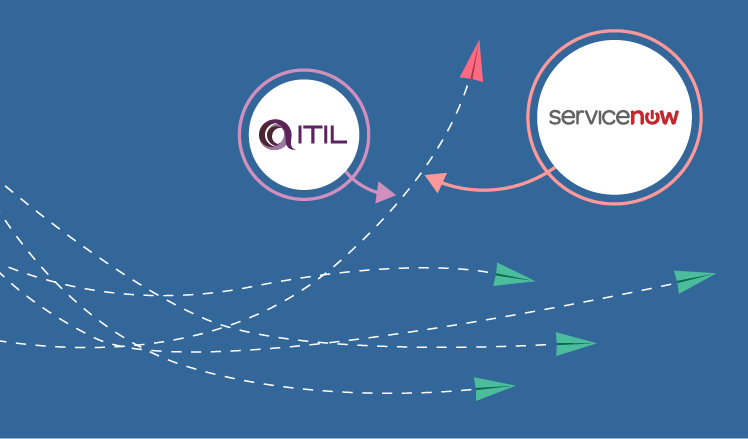Is ServiceNow® Platform Friends with ITIL Change Management? Let’s See
Have you ever seen one of those videos where the domino effect is shown in its most artistic and colorful way? One falling piece causes a chain reaction and in a few seconds all the dominos are already down forming some kind of a fantastic picture. In ITSM change management, we can also see the domino effect in action, and it can be fantastically devastating. Failing mismanaged IT changes influence other IT processes and cause more and more disruptions across your company. So that it doesn’t happen, businesses adopt ITIL-defined approach to change management. Using our ITSM consulting experience, we can help you explore practical aspects of it.
In the scope of ITIL change management, the term ‘change’ defines a process of altering something in a company’s IT processes or infrastructure that affects IT services. ITIL has a whole bunch of terms and best practices that are supposed to improve your ITSM change management. And it’s all very well in theory, but are all of ITIL change management dogmas applied in practice? The best way to see it is through analyzing ITSM platforms. And ServiceNow, being ITSM system #1 on the market, can help us with that.
So, does ServiceNow stand on the same terms as ITIL? These key aspects of ITSM change management in ServiceNow are to answer the question (though other points of comparison are also possible).

Types of changes
ITSM change management can’t function properly without differentiating changes, which is why ITIL highlights three major types of changes:
- Standard change
- Emergency change
- Normal change
Standard changes (SC) are frequently repeated low-risk alterations in IT processes or infrastructure that are easy, preapproved and skip a number of change process stages. Usually, it is easier for IT service managers to regard standard changes as such, to spare time for more arduous matters. If they processed SCs like normal changes, the overall change management would become too slow. An example of an SC would be adding a new switch to a network cabinet.
Emergency changes (EC) are alterations that require immediate attention. For instance, an email server does not respond. This issue disturbs the work of many users and requires action right away. The emergency change in this case would be adding more memory to the non-responsive server.
Normal changes (NC) are those that categorize as neither standard nor emergency. NCs are regarded as changes that can pose a particular threat to IT services, but there’s no need to act on them immediately. For example, changing the default route on a server.
Concerning the implementation of ITIL change management in ServiceNow, so far, it complies with all the types of changes, their definitions and use. Besides, it allows to create your own types of changes to make the change process more suitable for your company. And using Standard change catalog provides a possibility to manage standard changes even more effectively: create, approve, manage SC templates and optimize change management process.
Change management roles
Roles are one of the pillars ITSM change management stands on. ITIL defines the following change management roles:
- Change initiator - someone who sees the need for a change and begins the change management process.
- Change manager - someone who assesses a change, works out its implementation plan and monitors the overall change process.
- Change advisory board/CAB - a group of people who closely examine high-risk changes, authorize and review them.
- Change implementer/tester - someone who actually implements and tests the change.
Additionally, ITIL recognizes the possibility that the customer’s representative may also participate in the process (as a change approver).
And what about ServiceNow? Delegating in ServiceNow can be characterized in the following way:
- Such roles as initiator, manager, implementer and tester are almost not differentiated. They exist within one change management process, but there’s no rigid demand that a particular task be delegated to a particular employee, who can, for instance, only implement or test the change. It might make the process more dynamic but at the same time too hectic.
- Concerning CAB roles, ServiceNow has a special application for its activity, CAB workbench. It helps to schedule CAB meetings, appoint attendees, define agenda and monitor the process on the whole.
Change lifecycle
ITIL change management process can be illustrated as follows:
![]()
Change management process in ITIL can be seen somewhat bureaucratic. First, we identify the need for a change and create a change request. Then, the change gets carefully assessed, reviewed, planned and tested (you verify if everything works OK). Only after that a change proposal can be created. If, based on such a proposal, the change gets authorized, we can proceed with implementation, post-implementation review and closure.
But we should bear in mind that the full-cycle change process (as shown above) is characteristic only of the normal change. Standard and emergency changes skip particular stages to make their implementation process quicker.
ServiceNow change lifecycle looks a bit different:
![]()
The overall process looks quicker and less ‘bureaucratic.’The lifecycle is similar to ITIL, but with a couple of exceptions:
- Change requests and change proposals aren’t differentiated.
- There is an additional option to cancel a change.
- Testing takes place only at the last but one stage, when the staff has already performed all necessary implementation activities. It can make the process more ‘light-weight’, but if there’s less preparation before real action, it can get risky.
In addition, ServiceNow enables its users to add new change states, alter change workflows and tailor state transition criteria. You can also relate needed incidents, problems, tasks, configuration items, impacted services to the change form so that you have everything in one place. Besides, when you close a change, all associated incidents/problems are also closed automatically.
The result
ServiceNow change management has a couple of debatable points. Firstly, it doesn’t specify these roles: initiator, manager, implementer and tester. Secondly, change preparation seems insufficient (there’s no testing stage before implementation). However, these points don’t seem extremely crucial and can’t affect your change management that much.
Our verdict is that ServiceNow does provide quite a good change management ‘venue.’ Here’s why:
- In terms of ITIL-specified types of change, change management roles and change lifecycle, ServiceNow largely complies with core ITIL aspects.
- It allows a lot of flexibility to companies who need to tailor change management to meet their needs. They can create their own change types, add new change states, define other workflows for every change type and alter state transition criteria.
- There is a possibility to monitor change-related performance with the help of ServiceNow reporting and such KPIs as number of unsuccessful changes, backlog of changes and carried out emergency changes.
And given that ServiceNow change management is indeed worthy, it can be a good tool to prevent your IT processes from falling like dominos.

